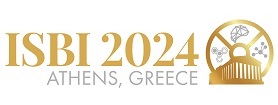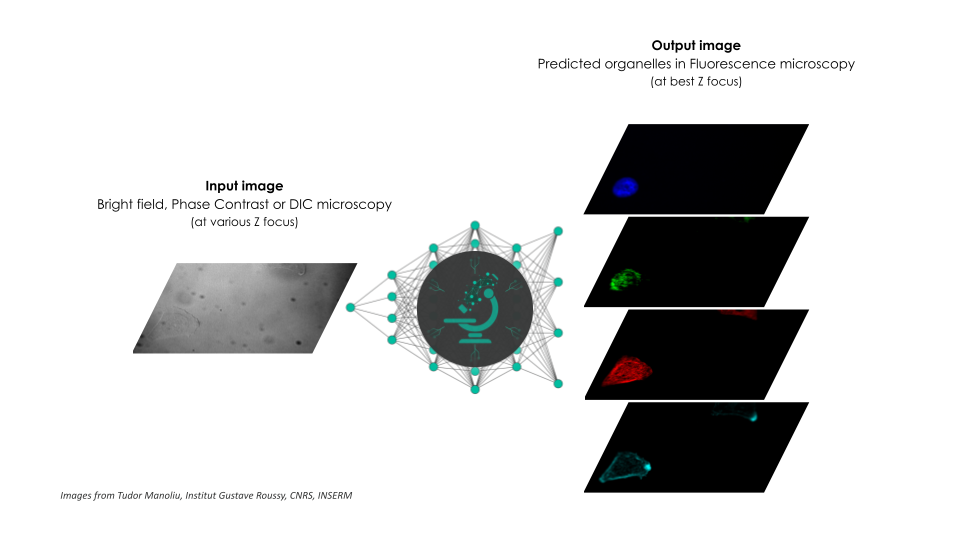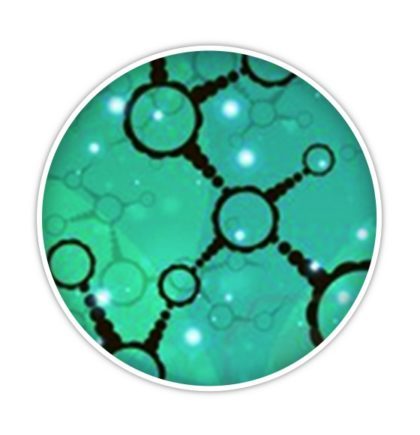Light My Cells :Bright Field to Fluorescence
Imaging Challenge

Part of ISBI 2024 in Athens, Greece!
🔎 About
The Light My Cells France-Bioimaging challenge aims to contribute to the development of new image-to-image ‘deep-label’ methods in the fields of biology and microscopy.
🧬 Task
The main task is to predict the best-focused output-images of several fluorescently labelled organelles from label-free transmitted light input-images.

🎯 Aim
The aim of this challenge is to produce new open source methods which can handle a large acquisition variability:
- Z-focus,
- Multiple channels,
- Acquisition sites,
- Input-modalities (Bright Field, Phase Contrast & Differential Interference Contrast (DIC)),
- Instruments,
- Magnifications,
- Cells
- Markers
The high variability of the database (more information here) is possible thanks to the structuring role of the France-Bioimaging infrastructure.
🧪 Biological & medical motivations
In
order to obtain fluorescence microscopy images, it is necessary to
perform a manual biochemical labelling treatment — time-consuming and
costly — over cells with specific fluorescent probes and dyes. But, the
cells studied may themselves be perturbed by the fluorescence microscopy
process, both by exposure to excitation light (phototoxicity) and by
the probes themselves.
As phototoxicity increases with light
exposure, it impairs long term imaging. Similarly, fluorophore dimming
through photobleaching limits the signal-to-noise ratio of the images.
Furthermore, adding markers is an invasive method. The fluorophore might
hinder its target's molecular interactions and protein overexpression
increases its concentration in the cytoplasm, disrupting regulation
processes. Worse, the fluorophores themselves can be cytotoxic.
As
fluorescence microscopy induces temporal and functional perturbations,
it is thus crucial for live microscopy to limit the number of
fluorescent probes used in an experiment.
On the contrary,
label-free transmitted light microscopy such as bright field, phase
contrast and DIC is non-invasive, phototoxicity is sharply reduced, and
the signal quality is conserved throughout the acquisition.
The biological aim of this challenge is to recover fluorescence images in silico from bright field images.
🚀 Technical motivations
We
want to give a boost for multi-output deep learning methods based on a
single input, when the training database is made up of images that do
not always include all the required channels and have a high degree of
variability (e.g. magnification, depth of focus, numerical aperture).
This leads participants to develop in particular new architectures and
loss functions dedicated for sparse output.
The purpose is to offer a
tool for biologists that can be robust on any acquisition protocol and
effective for the whole community, irrespective of the size of the
images, cell line, acquisition site, modality or instrument. In order to
assess the generalisability of the methods developed, we will exclude
one complete acquisition site from the training database and leave it
for the final evaluation. For the "Light my cells" challenge, we want to
evaluate the ability of the methods to predict the best Z-focus plane
for any organelle even in bad acquisition conditions. To achieve this
goal, participants will have the possibility to perform data
augmentation provided by the acquisitions. It consists in large Z-stacks
images of transmitted light microscopy containing a majority of out
focus planes.
We
defined metrics for each of the 4 organelles and for each (0 to 5)
deviations of the focus plane to measure the ability to perform the
task. We will evaluate each participant on this 4x6 metrics matrix, and
the winners (information about awards here) will be the ones with the best average of all the metrics (more information here).
Moreover,
participants will get an additional bonus for : code quality and
accessibility, lightweight deep learning model, short time of training
and prediction, and evaluation of the carbon footprint (more information here).
Among the current state-of-the-art approaches for image-to-image tasks in bio-imaging are "DeepHCS:
Bright-field to fluorescence microscopy image conversion using
multi-task learning with adversarial losses for label-free high-content
screening" (2021) and "Label-free prediction of cell painting from bright field images" (2022), both of which focus their methodologies solely on the use of the bright-field imaging modality, while "In Silico Labelling: Predicting Fluorescent Labels in Unlabeled Images" (2018) uses the same three modalities as our approach.
While
"DeepHCS" (2021) and "In Silico Labelling" (2018) use a wide range of
metrics to assess image quality, "Label-free prediction of cell
painting" (2022) uses a more restricted set of metrics.
However, these previous works present a very low diversity of applications and do not provide an easily accessible database.
In
addition, "DeepHCS" (2021) faces limitations due to the fixed sizes and
specific dyes of its database,"In Silico Labelling" (2018) uses fixed
formats that are not typical of those used in microscopy and similarly,
the authors of "Label-free prediction of cell painting" (2022) admit
limitations in the size and diversity of their database.
Nevertheless,
a more extensive and publicly accessible JUMP-CP database exists for
cell painting, which can be used for pretraining the 'Light My Cells'
challenge.
Yet to the best of our knowledge, the desired methods for
the 'Light my cells' challenge have no open source equivalent, and
aspires to be rooted with an open database and open algorithms.
 France BioImaging
France BioImaging
France
BioImaging (FBI) is a National Infrastructure in Biology and Health
(INBS), which federates 23 imaging acquisition sites distributed all
over France. It is the French node of Euro-BioImaging and a partner of
the Global BioImaging Network.
Its main role is to facilitate and coordinate research in biological imaging.
As an FBI project, the Light My Cells challenge want to innovate and give access to 'deep-label' imaging methods and create new standards for the biologists.
Do you like this project ?
Join the Light My Cells Challenge and dive into the future of imaging with us!
🏢 Institutions


